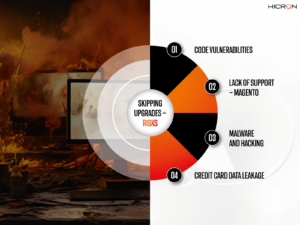As a system supporting online sales, Magento also requires regular maintenance, improvements, and upgrades. Our expert at Hicron – Michał Pawlak, Magento Developer and eCommerce Consultant, prepared a compendium of knowledge on Magento system upgrades.
Types of upgrades – what you need to know
If you want to better understand what a Magento upgrade is and why it is important, it is worth learning a little history around this system.
The story of a major migration – from Magento 1 to Magento 2
The origins of Magento date back to 2007, when its creator, Roy Robin, began working on the first version of this platform. It saw the light of day less than a year later. Between 2008 and 2014, Magento 1 gradually evolved. From version to version, the vendor improved the system with new functions and security features. At that time, Magento was bought by eBay, which resulted in the creation of a completely new version of the system in 2015 – Magento 2. The following years were marked by a stable development of the platform towards e-commerce. 2018 brought another breakthrough in the life of this project. Adobe, a technology company that produces software such as Photoshop and Illustrator, acquired Magento for over $1.5 billion. Then the software started to develop very dynamically.
Support for the first version of the platform ended in June 2020. This means that Magento 1 is no longer under development and no security patches will be released for this version of the engine. It should be noted that Magento 1 is an engine that uses PHP, Apache, MySQL, and jQuery. However, it does not support newer technologies such as HTML5 or CSS3, which Magento 2 offers. The newer version uses Nginx, Varnish, Redis, Symfony, and Composer in addition to the technologies mentioned above. Such solutions offer many possibilities for creating advanced online stores. Despite many very advanced features, the original version of the system is no longer as well suited to dynamically changing market conditions. One of the major shortcomings of Magento 1 is the inability to build web applications according to PWA requirements. In an age where most online purchases are made on mobile devices, Magento PWA is a huge opportunity to increase sales. The first version is also complicated to use, unresponsive, and difficult to implement compared to the new one. Compared to Magento 2, it has significant shortcomings.
Types of Magento updates
- regular updates – fix specific bugs in specific versions of Magento,
- security patches – Magento, like other applications, is susceptible to security bugs and potential cyber threats; to protect your system, Magento regularly releases security patches designed to fix issues and increase overall security; such patches protect against data theft or financial fraud,
- upgrading Magento to a newer version, e.g. from 2.4.6 to 2.4.7 – it ensures efficient operation of the platform, updates of its features, as well as seamless integration with the latest extensions; regular upgrades to newer versions of the solution allow you to maintain the functionality and innovation of the online store, thus improving the quality of customer experience.
Why should you upgrade Magento?
Efficient operation is extremely important for the continuous development of an online store. An online sales site is a long-term investment that will yield satisfactory returns if it is continuously maintained. One of the aspects of improving e-commerce sites is updating them.
Why is it important to upgrade Magento?
First, it ensures the security of an online store and protects against potential vulnerabilities or hacking attempts. Newer versions of Magento include patches and updates to fix all known security issues.
Second, upgrading to the latest version of Magento gives you access to new solutions and features that can improve user experience, increase conversions, and help you stay competitive in the e-commerce market.
Third, upgrading to the latest version of Magento also improves the performance and scalability of the store. The latest version of Magento is optimized to work faster and handle more traffic, resulting in faster page load times and greater Customer satisfaction.
However, if these arguments are not enough, remember that not upgrading to the latest version of Magento can lead to various problems such as security vulnerabilities and incompatibility with other extensions and themes. This could have very negative consequences for companies. Skipping an upgrade significantly increases the likelihood that many of the features of an online store will be limited or even disabled, reducing its availability to Customers or the users responsible for running it.

Risks related to upgrades and their mitigation
Like all changes, upgrades also involve some risk. Inexperienced staff or an inappropriate strategy for making corrections in the Magento system can lead to complications.
Here are the most common ones and a tip on how to deal with them:
- data loss – back up your files and database before making any changes to the system,
- lack of compatibility of modules with a higher version of PHP required by the installed upgrade – you need to upgrade the modules to their higher version (in the case of external providers) or adapt them yourself in the case of modules written by users on the system owner’s side,
- incompatibility of modified views (store layout) – adjustment by users on the system owner’s side (also with the support of experts specializing in Magento maintenance).
Skipping upgrades – risks
Magento systems that are not regularly upgraded can face much more serious dangers than those associated with skipping updates.
Below are examples of the most serious ones.
- Code vulnerabilities – as the software is developed, new features are added, bugs are fixed, and the code is optimized. However, this also means that older versions of the software may contain known vulnerabilities that have been discovered and fixed in newer versions. These vulnerabilities could be exploited by an attacker to gain access to sensitive information, steal data, or cause a denial of service attack. Upgrading to the latest version of Magento can help close these gaps and protect your site.
- Lack of support – Magento releases updates, patches, and security fixes for the latest version only. Once the vendor stops developing an older version of the software, it no longer receives updates, fixes, or support. Using an older version of Magento puts your site at greater risk of security breaches.
- Malware and hacking – outdated versions of Magento may be more vulnerable to malware and hacking. Hackers often target older versions of software because they are more likely to have known vulnerabilities that can be exploited. Updating to the latest version of Magento can help prevent these types of threats by closing known vulnerabilities and implementing new security features.
- Credit card data leakage – if a vendor offers online payments on their Magento site and is using an older version, their system may be at greater risk of payment data being compromised. Payment Card Industry (PCI) compliance regulations require merchants to protect their customers’ payment information. Previous versions of Magento may not meet these requirements. Updating to the latest version can help protect customer payment information and ensure PCI compliance.

How to update Magento? – action plan
Ensuring a safe upgrade is often a matter of a solid strategy.
Our expert at Hicron – Michał Pawlak, Magento Developer and eCommerce Consultant, suggests the following plan of action in connection with a Magento upgrade:
- All actions before the actual upgrade should be performed on a test server first, to be able to revert to the original working settings in case of complications.
- Backing up files and the database.
- Upgrading the versions of tools such as PHP, Elasticsearch, Redis to those required by the new version of Magento.
- Upgrading the version of third-party modules to a version that supports the new version of Magento.
- Fixing code bugs caused by incompatibility of custom modules and files with the latest uploaded files.
- Testing the application and possibly fixing further bugs.
- After successful testing by the Client, upload the upgrade to the test server after completing steps 2 and 3.
Upgrade support tool
Many companies whose sales sites are based on Magento do not specialize in technology and do not need to in order to effectively upgrade the system.
Support in upgrading Magento 2 is provided by a tool developed by the vendor. It can be found at this link: https://experienceleague.adobe.com/en/docs/commerce-operations/upgrade-guide/upgrade-compatibility-tool/overview
It ensures the compatibility of the Magento upgrade. It is a command line provided by Adobe that helps sellers check their store’s compatibility with the latest Magento version upgrade. The tool analyzes the compatibility of existing site features, external extensions, and customizations with the new version of the system. It lists potential issues so that they can be resolved or even avoided during the upgrade process.

Hicron – reliable expert support for Magento upgrades!
Our organization is constantly developing a team of specialists responsible for the implementation of e-commerce projects. Consultants assigned to online sales projects support Clients not only by recommending upgrades to the latest versions of Magento, but also by delegating them to professional Hicron teams. They perform upgrades on Clients’ systems so they do not have to do it themselves. At Hicron, we understand the risks associated with every change in different Magento versions. We can detect them before you upgrade by analyzing your application code and infrastructure. After the upgrade process, we can repair any bugs and restore the full operation of the application and its functionality. Additionally, we perform all upgrade-related activities on a test server. Only when it is 100% safe and approved by the Client, do we upload the upgrade to the application production server. In this way, we minimize the risk of business interruption or serious errors.
Looking for professional Magento support, maintenance, and security services? Contact Hicron e-commerce consultants!





